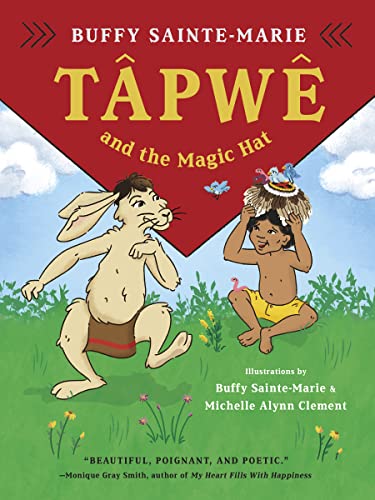Let’s tell a pop culture-savvy upper elementary school student that they’re going to read a book about the Kree and that it also involves a trickster. This trickster isn’t 100% evil and their acts of kindness are as unpredictable as their tricks. Based on that rough description they’re apt to think that they’re reading a mash-up between Marvel space aliens and Loki. However, Tapwe and the Magic Hat is a much more grounded fable about the Plains Cree indigenous people who made up a majority of the population of North America hundreds of years ago.

It’s worth noting that this is a book that is very friendly to those middle and upper elementary school readers, as well as those older readers who are interested in cultural studies. However, if you were to introduce it to a group of general interest readers described as that, you’ll have fewer readers than if you were to generically describe the book as we did at the start of the post.
The cover of Tapwe will certainly draw in some readers. It shows a human-sized anthropomorphic rabbit who is playing with a human boy wearing a hat with four birds living in it. That’s something that you don’t see every day. It’s also one of the cool things that a fable, as opposed to other types of children’s books can do. Having said that, Tawpe and the Magic Hat is not a true fable, it’s a work of contemporary fiction. Readers will be forgiven for thinking otherwise because this is a book that walks the walk, to borrow the classic from Ric Flair (again).
Tapwe is a middle school-aged boy who spends his summers with his grandmother while his mother attends school at the tribal college. However, this summer he’s going to go spend some time with his second cousins who live in a small village. His grandmother knows that Tapwe is always up for an adventure, so sure enough he eagerly goes out to the village.
Tapwe is quickly immersed into the more ceremonial aspects of his heritage. He sees some tribal dances, has big dinners with all of his family and can enjoy the wide-open aspects of nature. Tapwe can use his imagination to look at the clouds and see things. One of the first things he thinks that he sees is a large rabbit. One of his relatives gives him two gifts, one of which being a magical hat that has a series of birds that live in it. The other gift is a word of advice: watch out for the tricksters.
Wapos is a rabbit that we see on the cover of Tapwe and the Magic Hat. When Tapwe meets Wapos his relatives are hopeful that he’s mature and smart enough to handle the twists that the trickster could present to him.
Think of the magic hat and the trickster as potentially working in synch or in opposition to one another. When things with Tapwe are going well the birds in his hat are happy, singing and quite lively. When Tapwe is making poor decisions his hat resembles more of a cheap costume piece with plastic birds on top of it.
As Tapwe gets to know the people he’s spending the summer with he faces more temptations, as well as, many influences that could be helpful. That’s where the line between fable and fiction blurs with Tapwe and the Magic Hat. Each chapter is around four pages long, which is short enough for those middle elementary school students to be able to read. They’re also presented in a very patient, old-school, calming manner that feels like a fable being presented through a contemporary lens. It’s an allegory! Even after reading Tapwe and the Magic Hat I found it tough to really categorize, but an easy and charming book to recommend. This is an elementary school book that old souls will run across and really enjoy. Its length is short enough to where it won’t repel reluctant readers, and the illustrations in the book will certainly help those younger readers accept a book that doesn’t present as much flash as those that they’re used to.
Tapwe and the Magic Hat is Buffy Sainte-Marie with illustrations by Buffy Sainte-Marie and Michelle Alynn Clement and available on Greystone Kids, an imprint of Greystone Books.
There are affiliate links in this post.




 Facebook
Facebook Twitter
Twitter Flickr
Flickr GooglePlus
GooglePlus Youtube
Youtube